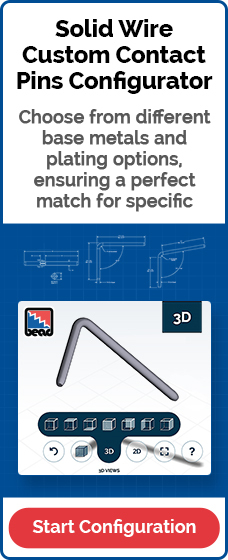Electronic sensors are essential for various military surveillance, intelligence, ordinance, and combat technologies. Sensors used in military applications need to be reliable, dependability, durable, and efficient. They must not only be reliable but be able to withstand the harsh conditions that come with extreme environmental conditions and warfare. This requires the sensors to have quality electrical connectors that are resilient and can produce powerful signals.
Without sensors, much of the defense technology used by the military would not be possible. This includes the innovations in communication, surveillance, and transportation used today.
Here's a comprehensive guide of different types of military sensors and how they are used.

Sensors Used in Military Applications
Types of sensors for military use include:
- Micro-electro-mechanical systems (MEMS)
- Active sensors
- Wearable sensors
- Smart sensors
- Nanosensors
- Camera sensors
- Infrared sensors
Sensors used in military applications have highly specific requirements that must be met. In addition to durability and resilience, they must meet high signal and power requirements, so they can function in a wide range of harsh conditions.
These sensors have to be effective even when exposed to dirt, mud, water, and other types of debris that would cause them damage, not to mention, shock and vibrations. To avoid these environmental damages, military sensors may have quality sealing and quick-cleaning features, as well as stabilizations—or strong connectors—in place.
MEMS Sensors
MEMS sensors are popular for a variety of uses in the military because of their:
- Compact size
- Cost-effectiveness
- Reliable performance
They can work as pressure sensors inside aircraft, water-in-fuel sensors, and friend-or-foe identification. They are also used in remote satellites to accumulate data, direct rockets, and improve security. They are also adapted to a wide range of uses, such as in automotive, and medical applications.

Active Sensors
Active sensors use an external power source to send out a signal or wavelength of light, so they can detect changes in the environment.
These sensors are essential for military devices that are used to detect objects in an area, such as radars and sonar. Such devices are used in:
- Air defense
- Surveillance
- Navigation
- Search and rescue
- Weapon fire control
- Weapons-locating systems
Military active sensors use their own sources of radiation to illuminate objects. The energy is reflected back to the sensors and measured to reveal the object's distance and movement.
Wearable and Smart Sensors
Military wearables can collect data and transmit signals for training and in-field purposes. They can be comfortably worn on the body, providing increased portability.
Wearables provide improved ways to:
- Track a soldier's location and vitals
- Provide new ways to communicate mission-critical information
- Train soldiers using augmented and virtual reality devices
Wearable sensors must function adequately in areas with low bandwidth. They must also have measures in place to decrease the risk of crosstalk and protect against interference.
For this reason, many wearables—like smart vests—also function as smart sensors.
Smart sensors are user-friendly, multifunctional, self-diagnosing, and much more. They are reliable, provide better connectivity, and allow for more efficient data communication.
Nanosensors
Nanosensors are mechanical or chemical sensors that often have one of their dimensions smaller than 100 nm. They are able to collect data about particles on the nanoscale level.
Nanosensors are useful for:
- Medical diagnostics
- Chemical detection
- Determining the quality of food and water
These sensors can also be used to improve clothing materials and make them stronger, lighter, and more adaptive. This improves their protective capabilities and helps increase mobility.
Camera & Surveillance Systems
Sensors are essential for various security systems, such as intrusion detection systems. They are also used for environmental monitoring and surveillance:
- On land
- Underwater
- On aerial platforms
- In satellites
Camera sensors are essential for a variety of surveillance systems.
These sensors are useful for face, motion, and scene detection and are effective at tracking targets based on their IR light emission.
They improve a surveillance system's ability to detect the speed and direction of caught movement. Camera sensors can also help reduce blurring and improve the feed's visibility.

Infrared & Weaponry Controls
Sensors are used in many different types of weaponry to improve their ability and accuracy.
They are used in:
- Explosives detection systems
- Chemical warfare
- Missile systems
- Target and weapon seekers
The infrared sensor is often used to improve weapon accuracy and effectiveness. The IR sensor's ability to detect minute details over long distances helps locate, image, and track targets. It allows for the early detection of potential threats and whether an incoming person is a friend or foe.
Sensors in Aerospace Applications
Sensors that are for aerospace use need electrical connectors that:
- Are low-weight
- Have high durability and reliability
- Need little maintenance
This is especially true of flight sensors for military use. These sensors are essential for improved flight controls and navigation in low-visibility conditions.
Infrared (IR) sensors are helpful for flight as they can detect details from far off. This helps improve flight navigation at night and in other poor visibility conditions.

Getting the Right Electrical Connectors for Military Use
Sensors used in military applications need to be reliable and resilient.
Bead Electronics has been producing high-quality electronic connector pins for over 100 years. We carry over 500 patents and are most well-known for inventing the swaging process. With our high-speed, cost-effective swaging process, we produce a wide size of connector pins that have consistently good quality, durability, and reliability. Our pins are customizable to meet the needs of a variety of industries that deal with harsh conditions, including for military and aerospace use.



